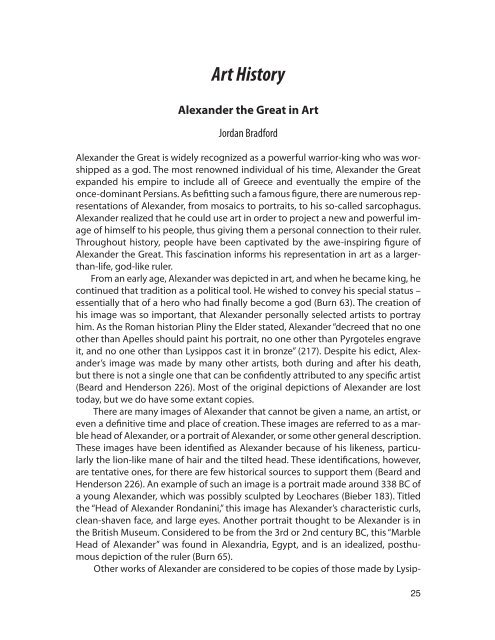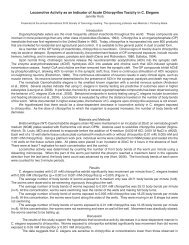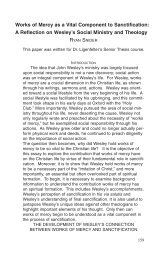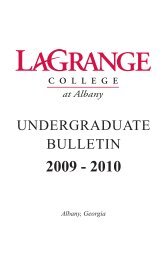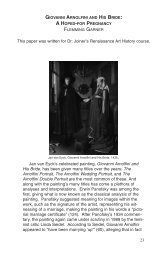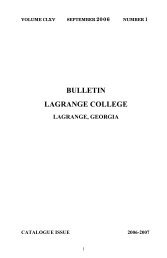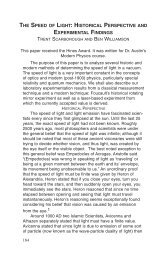Alexander The Great in Art
Alexander The Great in Art
Alexander The Great in Art
You also want an ePaper? Increase the reach of your titles
YUMPU automatically turns print PDFs into web optimized ePapers that Google loves.
<strong>Art</strong> History<br />
<strong>Alexander</strong> the <strong>Great</strong> <strong>in</strong> <strong>Art</strong><br />
Jordan Bradford<br />
<strong>Alexander</strong> the <strong>Great</strong> is widely recognized as a powerful warrior-k<strong>in</strong>g who was worshipped<br />
as a god. <strong>The</strong> most renowned <strong>in</strong>dividual of his time, <strong>Alexander</strong> the <strong>Great</strong><br />
expanded his empire to <strong>in</strong>clude all of Greece and eventually the empire of the<br />
once-dom<strong>in</strong>ant Persians. As befitt<strong>in</strong>g such a famous figure, there are numerous representations<br />
of <strong>Alexander</strong>, from mosaics to portraits, to his so-called sarcophagus.<br />
<strong>Alexander</strong> realized that he could use art <strong>in</strong> order to project a new and powerful image<br />
of himself to his people, thus giv<strong>in</strong>g them a personal connection to their ruler.<br />
Throughout history, people have been captivated by the awe-<strong>in</strong>spir<strong>in</strong>g figure of<br />
<strong>Alexander</strong> the <strong>Great</strong>. This fasc<strong>in</strong>ation <strong>in</strong>forms his representation <strong>in</strong> art as a largerthan-life,<br />
god-like ruler.<br />
From an early age, <strong>Alexander</strong> was depicted <strong>in</strong> art, and when he became k<strong>in</strong>g, he<br />
cont<strong>in</strong>ued that tradition as a political tool. He wished to convey his special status –<br />
essentially that of a hero who had f<strong>in</strong>ally become a god (Burn 63). <strong>The</strong> creation of<br />
his image was so important, that <strong>Alexander</strong> personally selected artists to portray<br />
him. As the Roman historian Pl<strong>in</strong>y the Elder stated, <strong>Alexander</strong> “decreed that no one<br />
other than Apelles should pa<strong>in</strong>t his portrait, no one other than Pyrgoteles engrave<br />
it, and no one other than Lysippos cast it <strong>in</strong> bronze” (217). Despite his edict, <strong>Alexander</strong>’s<br />
image was made by many other artists, both dur<strong>in</strong>g and after his death,<br />
but there is not a s<strong>in</strong>gle one that can be confidently attributed to any specific artist<br />
(Beard and Henderson 226). Most of the orig<strong>in</strong>al depictions of <strong>Alexander</strong> are lost<br />
today, but we do have some extant copies.<br />
<strong>The</strong>re are many images of <strong>Alexander</strong> that cannot be given a name, an artist, or<br />
even a def<strong>in</strong>itive time and place of creation. <strong>The</strong>se images are referred to as a marble<br />
head of <strong>Alexander</strong>, or a portrait of <strong>Alexander</strong>, or some other general description.<br />
<strong>The</strong>se images have been identified as <strong>Alexander</strong> because of his likeness, particularly<br />
the lion-like mane of hair and the tilted head. <strong>The</strong>se identifications, however,<br />
are tentative ones, for there are few historical sources to support them (Beard and<br />
Henderson 226). An example of such an image is a portrait made around 338 BC of<br />
a young <strong>Alexander</strong>, which was possibly sculpted by Leochares (Bieber 183). Titled<br />
the “Head of <strong>Alexander</strong> Rondan<strong>in</strong>i,” this image has <strong>Alexander</strong>’s characteristic curls,<br />
clean-shaven face, and large eyes. Another portrait thought to be <strong>Alexander</strong> is <strong>in</strong><br />
the British Museum. Considered to be from the 3rd or 2nd century BC, this “Marble<br />
Head of <strong>Alexander</strong>” was found <strong>in</strong> Alexandria, Egypt, and is an idealized, posthumous<br />
depiction of the ruler (Burn 65).<br />
Other works of <strong>Alexander</strong> are considered to be copies of those made by Lysip-
pos, for, accord<strong>in</strong>g to the historian Plutarch, “only Lysippos, it seems, brought out<br />
his real character <strong>in</strong> the bronze and gave form to his essential excellence” (Plutarch<br />
50). In one portrait, called the Azara Herm, Lysippos characterized <strong>Alexander</strong> not as<br />
a god, as Apelles and Pyrgoteles did, but as a vigorous and thoughtful man. Accord<strong>in</strong>g<br />
to Margaret Bieber, Lysippos captured the “manl<strong>in</strong>ess and lion-like fierceness of<br />
his countenance” as well as the “softness, brightness, and melt<strong>in</strong>g glance of his eyes”<br />
(183). <strong>The</strong> Azara Herm, now <strong>in</strong> the Louvre, is recognized as <strong>Alexander</strong> because of its<br />
<strong>in</strong>scription, “<strong>Alexander</strong>, son of Philip of Macedon” (Bieber 183).<br />
Possibly the best known depiction of <strong>Alexander</strong> is the <strong>Alexander</strong> Mosaic, which<br />
was found <strong>in</strong> 1831 <strong>in</strong> the House of the Faun at Pompeii. <strong>The</strong> scene <strong>in</strong> the mosaic is<br />
that of <strong>Alexander</strong> either at the Battle of Issos <strong>in</strong> 333 BC or the Battle of Gaugamela<br />
<strong>in</strong> 331 BC, fight<strong>in</strong>g with the Persian emperor Darius (Stewart 133). Amidst the chaos<br />
and death of the battle, this scene captures the exact moment when <strong>Alexander</strong>’s<br />
charge causes Darius to retreat, and thus symbolically represents the pivotal turn<strong>in</strong>g<br />
po<strong>in</strong>t that leads to the fall of the Persians and the rise of <strong>Alexander</strong> the <strong>Great</strong>.<br />
<strong>The</strong> battle shows the bravery of <strong>Alexander</strong>, s<strong>in</strong>ce he is lead<strong>in</strong>g his army aga<strong>in</strong>st the<br />
Persians without a helmet. Darius is portrayed as weak compared to <strong>Alexander</strong> because<br />
of his gesture of entreaty and the flight of his charioteer. <strong>The</strong> dead tree <strong>in</strong><br />
the background also plays an important part <strong>in</strong> the image. For Andrew Stewart, it<br />
becomes a “metaphor for the death and dismemberment of the Persian Empire”<br />
(140). Considered to be a second-century BC copy, and portrayed so prom<strong>in</strong>ently <strong>in</strong><br />
a Roman house many years after his death, this mosaic demonstrates the endur<strong>in</strong>g<br />
appeal of <strong>Alexander</strong> the <strong>Great</strong> (Burn 40-41).<br />
Another famous representation of <strong>Alexander</strong> is that on his sarcophagus, which<br />
was made <strong>in</strong> the 4th century BC. <strong>The</strong> <strong>Alexander</strong> Sarcophagus, found at Sidon, <strong>in</strong><br />
modern-day Lebanon, was used for a royal burial, perhaps that of K<strong>in</strong>g Abdalonymos,<br />
who was <strong>in</strong>stalled on the throne by <strong>Alexander</strong> after the Battle of Issos (Webster<br />
38). Shaped like a m<strong>in</strong>iature temple with the lid patterned after a pediment, the<br />
sarcophagus has four battle and two hunt<strong>in</strong>g scenes. One scene shows a lion hunt,<br />
<strong>in</strong> which <strong>Alexander</strong> is likened to Heracles hunt<strong>in</strong>g a lion and later wear<strong>in</strong>g its sk<strong>in</strong>.<br />
Abdalonymos is probably one of the figures next to <strong>Alexander</strong>, perhaps to strengthen<br />
his own reputation and importance as a ruler (Burn 43). <strong>Alexander</strong> is also <strong>in</strong> one<br />
of the battle scenes, along with his closest friend Hephaestion. <strong>The</strong> other hunt<strong>in</strong>g<br />
scene is one of a panther, and another battle is between Greeks and Persians, with<br />
<strong>Alexander</strong> recognizable on the left (Webster 41).<br />
Regardless of who commissioned the <strong>Alexander</strong> Sarcophagus, it and the scenes<br />
on it were probably used by <strong>Alexander</strong>s’ successors, accord<strong>in</strong>g to Lucilla Burn, as<br />
a “technique of seek<strong>in</strong>g to legitimize and popularize themselves by reference to<br />
their illustrious leader” (43). Even after his death <strong>in</strong> 323 BC, <strong>Alexander</strong>’s image was<br />
recreated and glorified as one of strength, power, and div<strong>in</strong>ity. On account of his<br />
overwhelm<strong>in</strong>g popularity with the people of Greece, his god-like status, and his<br />
likeness to the hero Heracles, <strong>Alexander</strong>’s contemporaries put his image to good
use <strong>in</strong> generat<strong>in</strong>g support for themselves.<br />
Images of <strong>Alexander</strong> cont<strong>in</strong>ued to appear after his death <strong>in</strong> many different<br />
media. Throughout his empire <strong>Alexander</strong>’s image was put on co<strong>in</strong>s <strong>in</strong> order to keep<br />
his memory alive, even though previously most co<strong>in</strong>s featured Heracles. Soon the<br />
co<strong>in</strong>s of <strong>Alexander</strong> and Heracles were <strong>in</strong>dist<strong>in</strong>guishable from each other, s<strong>in</strong>ce both<br />
began to take on the traits of <strong>Alexander</strong> (Stewart 163). Some co<strong>in</strong>s kept the likeness<br />
of Heracles, while others, such as those from Sidon, were closer to the characteristic<br />
head of <strong>Alexander</strong>. <strong>The</strong> best example of co<strong>in</strong>s bear<strong>in</strong>g <strong>Alexander</strong>’s image<br />
came from Babylon, where he last resided and died <strong>in</strong> 323 BC (Stewart 164). On the<br />
Babylonian co<strong>in</strong>s, accord<strong>in</strong>g to Bieber, “the protrud<strong>in</strong>g forehead, the large eyes, the<br />
slightly pendant tip of the nose, the full lips, the rounded ch<strong>in</strong>, and the elongated<br />
cheeks are certa<strong>in</strong>ly meant to be the features of <strong>Alexander</strong>” (Bieber 185). Most of<br />
<strong>Alexander</strong>’s co<strong>in</strong>s represent him wear<strong>in</strong>g the ram’s horn of the Egyptian deity Zeus<br />
Ammon, which is a significant portrayal that attributes yet another god-like quality<br />
to <strong>Alexander</strong>.<br />
Just as with the <strong>Alexander</strong> Sarcophagus, the co<strong>in</strong>s of <strong>Alexander</strong> were m<strong>in</strong>ted<br />
because of the political power they wielded over the Hellenistic people. <strong>Alexander</strong>’s<br />
successors’ adherence to his image on co<strong>in</strong>s, accord<strong>in</strong>g to Stewart, “proclaimed to<br />
their subjects and followers (their troops <strong>in</strong> particular) their cont<strong>in</strong>u<strong>in</strong>g allegiance<br />
to the concept of an undivided empire and boosted their own prestige by emphasiz<strong>in</strong>g<br />
their service with <strong>Alexander</strong>” (Stewart 264). As <strong>Alexander</strong>’s prestige and relevance<br />
lessened, however, these rulers started to replace his image with their own<br />
for the same reasons that <strong>Alexander</strong> himself first conveyed his own image to the<br />
public, <strong>in</strong> order for the people know him more personally.<br />
<strong>Alexander</strong> the <strong>Great</strong> is considered one of the most powerful rulers <strong>in</strong> history<br />
and can be categorized with figures such as Constant<strong>in</strong>e, Julius Caesar, and Napoleon.<br />
As a forerunner to the leaders who came after him, <strong>Alexander</strong> manipulated<br />
art to create a god-like status for himself. In do<strong>in</strong>g so, he fostered a near-obsession<br />
among his subjects and all those who have come afterward. <strong>The</strong> images that we<br />
study today admirably convey the <strong>in</strong>tense fasc<strong>in</strong>ation that generation after generation<br />
has had with the monumental figure of <strong>Alexander</strong> the <strong>Great</strong>.<br />
Works Cited<br />
Beard, Mary and Henderson, John. Classical <strong>Art</strong>: From Greece to Rome. NY: Oxford University<br />
Press, 2001.<br />
Bieber, Margarete. “<strong>The</strong> Portraits of <strong>Alexander</strong>.” Greece and Rome, Series 2, vol. 12, no. 2.<br />
Cambridge University Press (1965): 183-188. JSTOR. Web 28 November 2011.<br />
Burn, Lucilla. Hellenistic <strong>Art</strong>: From <strong>Alexander</strong> the <strong>Great</strong> to Augustus. LA: <strong>The</strong> J. Paul Getty<br />
Museum, 2004.<br />
Pl<strong>in</strong>y, Natural History. 77 AD. Pollitt, J.J. <strong>The</strong> <strong>Art</strong> of Ancient Greece: Sources and Documents.<br />
NY: Cambridge University Press, 1990. 217.<br />
Plutarch. Hellenistic <strong>Art</strong>: From <strong>Alexander</strong> the <strong>Great</strong> to Augustus. Burn, Lucilla. LA, 2004.<br />
Stewart, Andrew. Faces of Power: <strong>Alexander</strong>’s Image and Hellenistic Politics. CA: University<br />
of California Press, 1993. eBook collection (EBSCOhost). Web 28 November 2011.<br />
Webster, T.B.L. <strong>The</strong> <strong>Art</strong> of Greece: <strong>The</strong> Age of Hellenism. NY: Crown Publishers, Inc., 1966.<br />
Jordan Bradford


